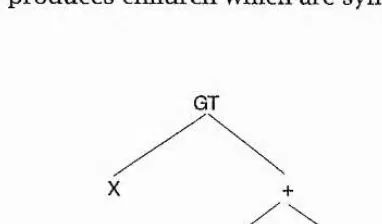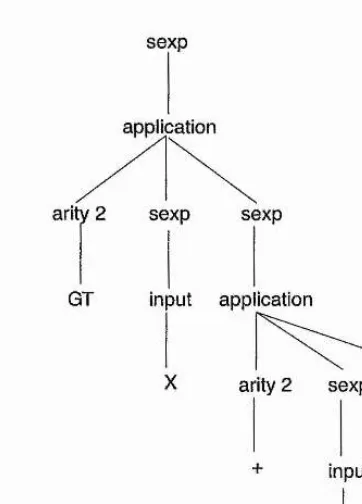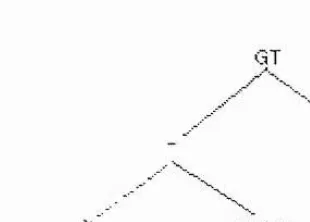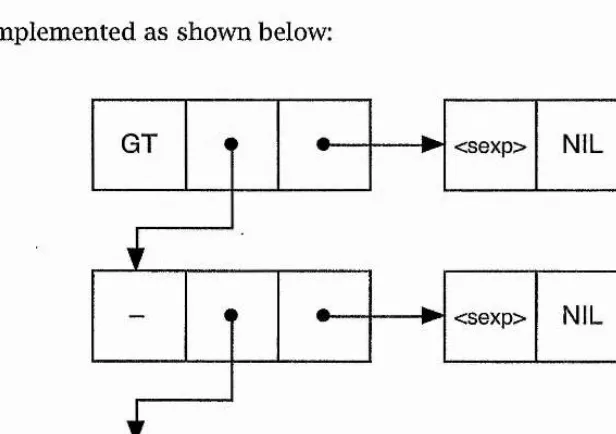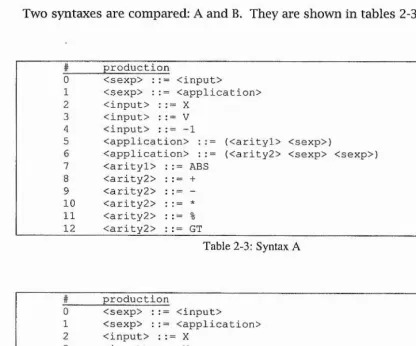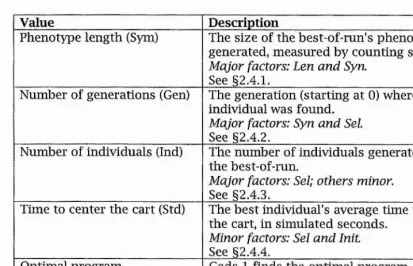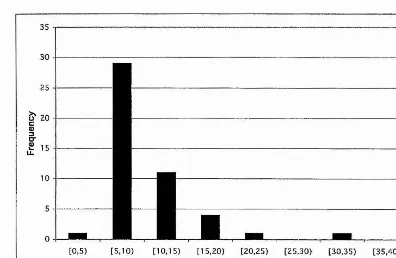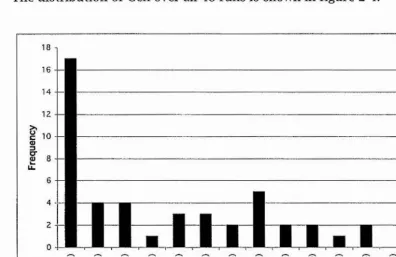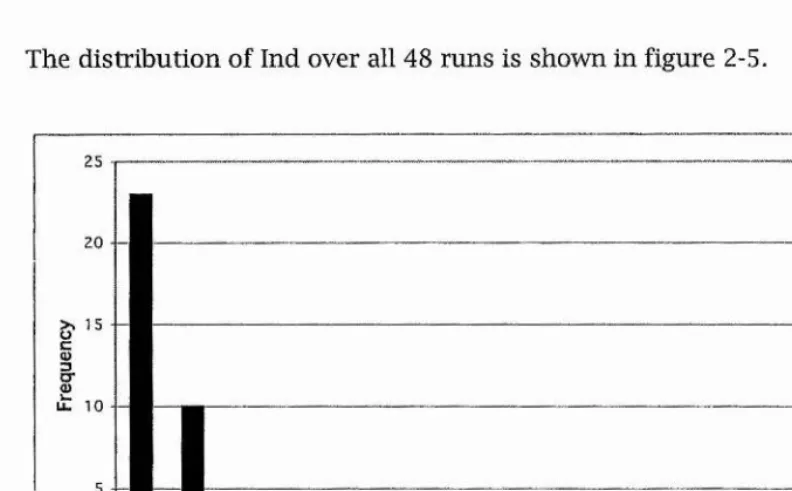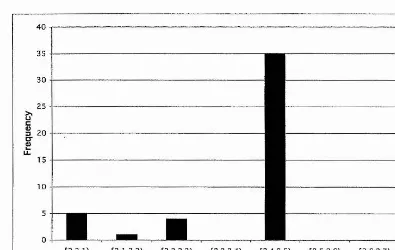GENETIC PROGRAMMING WITH
CONTEXT-SENSITIVE GRAMMARS
Norman Paterson
A Thesis Submitted for the Degree of PhD
at the
University of St Andrews
2003
Full metadata for this item is available in
St Andrews Research Repository
at:
http://research-repository.st-andrews.ac.uk/
Please use this identifier to cite or link to this item:
http://hdl.handle.net/10023/14984
Genetic programming with
context-sensitive grammars
Thesis submitted for the degree of Doctor of Philosophy
by
Norman Paterson
A?/-School of Computer Science
University of St Andrews
ProQuest Number: 10170995
All rights reserved INFORMATION TO ALL USERS
The quality of this reproduction is d ep en d en t upon the quality of the copy submitted. In the unlikely ev en t that the author did not send a co m p lete manuscript
and there are missing p a g es, these will be noted. Also, if material had to be rem oved, a n o te will indicate the deletion.
uest
ProQuest 10 1 70995
Published by ProQuest LLO (2 0 1 7 ). Copyright of the Dissertation is held by the Author.
All rights reserved.
This work is protected against unauthorized copying under Title 17, United States C o d e Microform Edition © ProQuest LLO.
ProQuest LLO.
789 East Eisenhower Parkway P.Q. Box 1346
m
Dedication
To my parents
John Campbell Paterson, 1908 — 1975
Abstract
This thesis presents Genetic Algorithm for Deriving Software (Gads), a new technique for genetic programming. Gads combines a conventional genetic algorithm with a context-sensitive grammar. The key to Gads is the
ontogenic mapping, which converts a genome from an array of integers to a correctly typed program in the phenotype language defined by the
Declaration
(i) I, Norman Paterson, hereby certify that this thesis, which is approximately 70 000 words in length, has been written by me, that it is the record of work carried out by me and that it has not been submitted in any previous application for a higher degree.
date ^ 4 -4 ' 2 ^ 3 signature of candidate
(ii) I was admitted as a research student in October 1995 and as a candidate for the degree of Doctor of Philosophy in October 1995; the higher study for which this is a record was carried out in the University of St Andrews
between 1995 and 2002.
date %4 4 signature o f candidate________
(hi) I hereby certify that the candidate has fulfilled the conditions of the Resolution and Regulations appropriate for the degree of Doctor of Philosophy in the University of St Andrews and that the candidate is qualified to submit this thesis in application for that degree.
Copyright
In submitting this thesis to the University of St Andrews I understand that I am giving permission for it to be made available for use in accordance with the regulations of the University Library for the time being in force, subject to any copyright vested in the work not being affected thereby. I also understand that the title and abstract will be published, and that a copy of the work may be made and supplied to any bona fide library or research worker.
Acknowledgements
Many people deserve acknowledgement for the help they gave in the execution of this work. Michael Livesey, as supervisor, was always able to show interest and listen to my endless and sometimes pointless thought processes. Without his support, this work would quite simply not have been possible. Ishbel Duncan offered to proofread: not a task to be undertaken lightly.
The staff and students of the School of Computer Science unwittingly gave support in that some of the time I spent on this part-time work can only have come from the time I should have spent on my full-time job as Senior Scientific Officer, which must have suffered in consequence.
Conor Ryan and Michael O'Neil from the University of Limerick showed that the original ideas had some merit, and their friendship helped me to feel less alone in a large world.
Acronyms & notations
But the scene o f this narrative is laid in the South of England and takes place in and around Knotacentinum Towers (pronounced as if written Nosham Taws), the seat o f Lord Knotacent (pronounced as if written Nosh).
But it is not necessary to pronounce either of these names in reading them.
Nonsense Novels, Stephen Leacock, 1911.
The following acronyms and notations are used without further elaboration throughout this thesis. I have tried to adopt the rule that acronym letters are named individually if in upper case, and pronounced phonetically if in lower case.
a
Ô
ADF
Probability of a type 1 error; level of significance.
Least d which can be detected 95% reliably.
Automatically defined function. A function whose definition is evolved automatically, and which may be used by other parts of the individual it is part of.
anova
Analysis of variance. BNF
Backus-Naur form or Backus Normal form. CFG
Context free grammar. CSG
Context sensitive grammar. d
Displacement; difference in means of two simulated populations. ECJ
A Java-based evolutionary computation and GP research system [Luke,
2001].
ES
EPF
ET
GA
Evolution strategy.
Empirical (or estimated) power function.
Expression tree. A tree showing an expression such as a Lisp S-
expression. All nodes are terminal symbols. Internal nodes have arity greater than 0. Leaf nodes have arity equal to 0. Contrast with PT.
Gads
Genetic algorithm for deriving software. Two editions of Gads are presented in this thesis. Gads 1 was previously described in [Paterson,
1996]. Gads 2 is described in this thesis for the first time. When neither edition is specified. Gads is a more general reference to any- edition in the series.
GE
GCL
GEP
GP
LHS
PT
rag
RHS
RMS
RNG
SA
sag
SGP
STGP
V
Grammatical Evolution, a GP system desribed in [Ryan, 1998a]. Historically, GE lies between Gads 1 and Gads 2.
Global confidence level, 95%.
Gene Expression Programming [Ferreira, 2001].
Genetic programming.
Left hand side (of a BNF production).
Parse tree. A tree showing the derivation or structure of a sentence according to a grammar. Internal nodes are nonterminal symbols and leaf nodes are termmal symbols. Also called derivation tree or syntax
tree. Contrast with ET. !
.1
Reflective attribute grammar. I
Right hand side (of a BNF production).
Root mean square.
Random number generator.
Simulated annealing.
Standard (ie non-reflective) attribute grammar.
Standard (ie Koza-style) genetic programming.
Strongly Typed GP [Montana, 1995] and [Clack, 1997].
Contents
INTRODUCTION.
O u t lin e o f GP
Using formal languages. 1.1
1.2 O u t lin e OF G a d s. 1.3 R e l a t e d WORK __
1.3.1
1.3.2 Mapping genotype to phenotype_
1.4 Mo t iv a t io n_________________________
1.4.1 7.4.2 1.4.3 1.5 1.6 Formal grammars Simple genotype__
Change in representation.
C o n t r i b u t io n ________________
Re a d in g g u id e
G A D S l 2.1
2.2 IP r in c ip le s n t r o d u c t io no fG a d s 1_______
2.2 2.2 2.2 2.2 2.2 2.2 2.2
2.3 Ex pe r im e n t a ld e sig n 2.3. 2.3 2.3. 2.j 2.3. 2.3. 2.5 2.3. 2.5 2.5
The phenotype language _
The ontogenic m apping_
The initial population____
Generating the phenotype Inapplicable productions _
Residual nonterminals___
Evaluation_____________
The problem___________
Experimental conditions^ The GA engine________
Generating the phenotype Evaluating the phenotype _ S yn tax________________
Initial valu e __________
Selection method Crossover______
2.4
Chromosome length.
E x p e r im e n ta l r e s u l t s
2.4, 2.4, 2.4 2.4, 2.4,
Phenotype length (Sym) ,
2.5
Number o f generations (Gen). Number o f individuals (Ind)_ Time to center the cart (Std)_ Optimal program__________
Co m pa r iso n s _________________
2.5, 2.5, 2.5, 2.6
2.6. 2.6,
2.6,
2.6,
2.6, 2.6,
2.6, 2.6.
2.6,
1 Phenotype length_____ 2 Number o f individuals 3 Initial population____
Qu e st io n sr a is e d_________
1 2 3 4 5 6 7
Specifying sentence distribution. Moving away from L isp_______
Functions, work variables etc Choosing sentence distribution Statistical analysis___________
Sequential chromosomes Gene effectiveness_____
Genetic operations_____
Initial distribution_____
STATISTICS 43
3.1 St a t ist ic a lper spec tiv e 43
3.1.1 Introduction 43
3.1.2 Populations and samples 45
3.1.2.1 Configurations 44
3.1.2.1.1 Populations 44
3.1.2.1.2 Samples 44
3.1.2.2 Runs 45
3.1.2.2.1 Populations 45
3.1.2.2.2 Samples 45
3.1.2.3 Individuals in generation 0 45
3.1,2.3.1 Populations 45
3,1.2.3.2 Samples 45
3.1.2.4 Individuals in generation n > 0 46
3.1.2.4.1 Populations 46
3.1.2.4.2 Samples 47
3.1.3 Experiments, outcomes, units and treatments 45
3.1.4 Random variation 49
3.1.5 Confidence level 50
3 .2 Pe r fo r m a n c e COMPARISON 51
3.2.1 Introduction 51
3.2.1.1 Related work 52
3.2.2 Experimental design 53
3.2.2.1 Tests and C-sample sizes 54
3.2.2.2 Factors 54
3.2.2.3 Trials and outcomes 55
3.2.2.4 Random variables 55
3.2.2.5 Bootstrapping 55
3.2.2.6 Hypotheses 56
3.2.2.7 Power functions 57
3.2.2.8 Alpha and delta 58
3.2.3 Results 55
3.2.3.1 Normality 58
3.2,3.2 Alpha and delta 59
3,2.3.3 Alpha 60
3.2,3.4 Delta 63
3,2.3.5 Coefficient of variation 63
3.2.4 Conclusions 64
3.2.4.1 Normality 65
3.2.4.2 Comparison of tests 65
3.2.4.3 Comparison of problems 66
3.2,4.4 Summary 66
3.3 Visu a l isa t io n 67
3.3.1 Introduction 67
3.3.2 Cost and benefit 68
3,3.2,1 Measures o f cost 68
3,3.2.2 Measures of benefit 69
3.3.2.3 Horses for courses 69
3.3.2,3.1 Arithmetic mean 70
3.3.2.3,2 Two kinds of difficulty 71
3.3,2.3.3 Equal importance 72
3.3.2.3.4 Distance between problems 73
3.3.2.3.5 Path length tree 74
3.3,2.3.6 Constructing the path length tree ... 79 3,3.2.3,7 Performance-based weights 82
GRAMMARS 84
4.1 Ex istin g C SGs 84
4.1.1 Two-level grammars 85
4.1.2 Attribute grammars 56
4.2 Reflec tiv ea t t r ib u t eg r a m m a r s 4.2.7 4.2.1.1 4.2.1.2 4.2.1.3 4.2.1.4 4.2.2 4.2.2.1 4.2.22 4.2.2.3 4.2.2.4 4.2.2.5 4.2.2.Ô 4.2.2.7 4.2.2.5 4.2.2.9
O verview_________________ Grammatical notation_______ Context free grammars_____ Standard attribute grammars _ Reflective attribute grammars
The S-algol rag ____________ Basic types_______________ Spaces __________________ Identifiers___________ Scope______________
For clause __________
Let declarations_____
Procedure declarations Literals_____________ Preamble, postamble, program. GADS 2
5.1 Theo r ig in sof Ga d s 2
5.1.1 5.1.2 5.1.3 5.1.4 5.1.5
Translation: mapping genes to productions, Repair: wrapping and defaults___________
Genotype : fixed length or variable length Genetic operators: crossover___________
Hobson's choice genes________________
5.2 Sy s t e m s______________________________________
5.2.1 5.2.2 5.2.3 5.2.4 5.2.5 5.2.6 5.2.7 5.2.5
Computing facilities___
Gads 2 implementation ECJ param eters______
Raw and transformed data scales___
Fitness: functionality and parsimony _ Crossover________________________
Hobson's choice, S -algol________
5.3 Pr o blem sa n din d iv id u a lr esu lts _
Monkey ____________________
C a rt________________________
5.3.1 5.3.2 5.5.5 5.5.4 5.5.5 5.5.6 5.5.7 5.5.5
Tile 1, Tile 2.
Multiplexer_ Power______
Two box___
F a ct_______
A nnie______
5.4 Co m pa r a t iv er esu lts
5.4.7 5.4.2 5.4.5 5.4.3.1 5.4.3.2 Pairwise comparison Visualisation ______
Rational scale comparison.
Problem weights — engine performance. Engine weights — problem performance. CONCLUSIONS
6.1 Co n t r ib u t io n
6.7.7 6.7.2 6.7.5 6.7.4 6.1.5 6.7.6
Context sensitivity , Non genetic search. Perform ance_____
Statistics______
Languages atul compilers Solution_______________
6.2 Lim it a t io n s___________________
6.2.7 Statistics _91 _97 _91 _93 _94 _95 _99 .100 .100 .102 .102 .106 .107 .112 .115 115 .117 .117 .7 7 5 .7 7 5 .7 2 6 .7 2 0 .725 .123 .725 .7 2 4 .7 2 4 .7 2 6
.727
.7 2 5 .7 2 5
.729
.129
.750
.754 .7 5 6 .747 .744 .747 .757 .762 .164 .767
.7 6 5
B
6.5.7 Specifving sentence distribution 179
6.5.2 Movins awav from Lisp 779
6.5.5 Functions, work variables, etc 750
6.3.4 Choosins sentence distribution 180
6.5.5 Statistical analysis 180
6.5.6 Sequential chromosomes 180
6.3.7 Gene effectiveness 180
6.5.5 Genetic operations 180
6.5.9 Initial distribution 180
.4 Fu t u r ew o r k 180
6.4.7 Statistics 75/
6.4.2 Grammars 182
6.4.5 Performance comparison 182
6.4.4 Analysis o f Gads 755
6.4.5 GP system design 755
6.4.6 Biological analogy 755
REFERENCES 185
S-ALGOL RAG 190
B.l Sy n t a x__________________________________________________________________________________190
B.2 Pr o d u c t io nMETHODS_________________________________________________ 223 B.2.1 Node______________________________________________________ 225
B.2.1 S_algolNode extends Node___________________________________________ 225 B.3 O b je c t CREATION____________________________________________________________ 237
Introduction
Genetic programming (GP) is a method for automatically developing computer programs. Automatic means that programs are produced by specifying what they are to do, not how they are to do it. For example, a function f which computes the square root of its argument may be specified by
This describes what f does, but it says nothing about how it might do it.
The current explosion of interest in GP was triggered by the publication of Genetic Programming: on the programming of computers by means of
natural selection [Koza, 1992], and most work in GP since then has been a
development of Koza's ideas. Koza's approach is the GP mainstream, and as
the de facto standard it is sometimes referred to as standard genetic
programming (SGP).
The remaining subsections of this introduction summarise this thesis and place it the context of other GP work, as follows:
§1.1 Outline of GP
Presents a general description of GP.
§1.2 Outline of Genetic Algorithm for Deriving Software (Gads) Introduces the main topic of this thesis: Gads.
§1.3 Related work
Places this thesis in context of current GP systems. §1.4 Motivation
Explains the aim of this work. §1.5 Contribution
Summarises the main contributions of this thesis. §1.6 Reading guide
1.1 Outline of GP
GP is a child of the genetic algorithm (GA). The seminal work on GAs is
Adaptation in natural and artificial systems [Holland, 1992]. In outline, GAs
work as follows. 1 Initialisation
Generate an initial population at random. 2 Evaluation
Compute the fitness of each individual in the population, which is a measure of how well it meets the requirements.
3 Breeding
Breed a new population, favouring fitter individuals as parents. 4 Termination
If the population contains an individual which meets the requirements, or if some other limit is reached, then stop. Otherwise continue from step 2.
For example, suppose we wish to design a roof truss in the form of a triangle with 2 braces on each side:
Figure 1-1: R oof tiuss
The fitness of an individual design is computed by means of a fitness
function. The fitness function is problem-specific, and is essentially a
definition of the problem to be solved. Continuing with the truss example, the fitness function could be a procedure which takes the 4 real numbers as arguments and computes properties such as cost, weight, or strength. Which properties are computed depends on the aim of the exercise. The result is a scalar value representing how good the individual is. The individuals in the initial population can be expected to be of poor quality, but they will not all be equally poor. By chance, some will be better than others.
Parents are chosen to breed a new generation in such a way that fitter parents are more likely to be selected. The crossover technique is used to produce children. Each parent is split in two at some position along its length, and a child is formed by joining the first part of one parent with the second part of the other. By joining the other two parts, a second child can be produced at the same time for little extra effort. If the representation is fixed length, then both parents must be split at the same position. Various modifications of this simple form of crossover, and various other genetic operations such as mutation, are used. With the truss example, since a parent consists of only 4 reals, there are only 3 internal crossover points.
Notice that GA does not guarantee to find a solution or stop within any specified number of steps. In practice it continues until a satisfactory solution is found, or some resource is exhausted.
For evolution to work, two things are necessary: the fitness of the children must correlate with the fitness of the parents, and there must be variation in the children's fitness. These two conditions result in a situation where cliildren sometimes outperform their parents. In this environment, selective breeding acts like a ratchet, evolving ever fitter individuals.
There are countless possible variations to each step. For example, the data type of individuals is not limited to one-dimensional arrays; multi
dimensional arrays, graphs and other data types have been used
[Michalewicz, 1994]. Fitness may be a single scalar value, or there may be multiple objectives. There may be multiple subpopulations, with migration from one subpopulation to another. There may be different species in competition with each other. The best individuals may be guaranteed a place in the new population (elitism). Crossover need not be hmited to word boundaries. A degree of random mutation may be introduced. The
To apply the GA model to the evolution of programs, some changes are needed. If programs were represented as character strings, it would be possible to use the GA model directly, with an array of characters rather than real numbers. But in such a scheme, children would very rarely be syntactically valid. For example, the probabihty that even the opening and closing parentheses would match in a child formed by concatenating parts of two parent programs split at random would be infeasibly small. SGP therefore uses a different form of representation for its individuals: the expression tree (FT). Figure 1-2 shows the FT for the Lisp expression "(GT X (+ X V))". In this expression, "GT" stands for greater than, and the whole expression is Lisp for x > (x + v). All nodes of the FT are terminal symbols of the grammar. Internal nodes are functions or operators which take arguments. External nodes are variables or constants which take no arguments. Crossover in SGP is defined to swap whole subtrees between two parents. Mutation can also be redefined in terms of subtrees. The language of the individuals can be defined in such a way that this form of crossover always produces children which are syntactically and semantically valid.
X V
Figure 1-2: Expression tree for "(GT X (4- X V))"
SGP programs are usually S-expressions in a first-order subset of Lisp augmented with special-purpose functions relevant to the problem domain. Lisp has the advantage that S-expressions are themselves Lisp objects. It is therefore possible to manipulate individuals for operations such as
crossover, and then to evaluate them to compute their fitness.
An example of a fitness function for a square root function is as follows. We first define the root mean square (RMS) error in fas:
[image:19.616.204.395.308.420.2]This can be done by an expression such as:
1 fitness[f)
\ + R M S ( f )
It should be noted that applying a GA to a data type other than a linear list or array — even to trees — is not peculiar to SGP. [Michalewicz, 1994] describes the application of GAs to many different data types. What is unique to GP in general and SGP in particular is the principle that the individual — however represented — represents an executable program.
Given the above outline it is perhaps not surprising that GA and GP are often described with reference to On the origin of species by means of
natural selection [Darwin, 1859]. Although this is understandable, it is not
accurate, because neither GA nor GP are concerned with the evolution of new species, nor do they use natural selection. Even multi-species GP systems do not aim to produce new species. So far from using natural selection, in which there is no distant goal, both GA and GP require an explicit fitness function to be provided by the user to direct the selection towards the user's goal. It follows that GA and GP are based not so much on Darwin as on the selective breeding programmes for animals and plants which date from prehistorical times. [Koza, 1996a] refers to animal
husbandry. What is different is that following Darwin we have a better
understanding of the principles by which such programmes work. Genesis chapter 30 verses 37-42 describes a selective breeding programme in existence before the principles were understood.
1.2 Outline of Gads
The main components of a Gads system are: 1 An evolutionary system such as a GA; 2 A formal grammar for the desired language;
3 An ontogenic mapping from genotype to phenotype;
4 A fitness function which defines the problem to be solved.
Of these, the evolutionary system and the fitness function are standard and are not explained further here. The use of a formal grammar and the ontogenic mapping from genotype to phenotype require explanation. An outline explanation is given below.
Formal granunars have been used to specify programming languages for many years. [Naur, 1963] introduced Backus-Naur form (BNF) to give a context-free definition of Algol 60. Context-free grammars (CFGs) are simple to understand, but to represent the context-sensitive aspects of a language, it is necessary to use a context-sensitive grammar (CSG). The most commonly used type of CSG is the sag [Pagan, 1981].
sexp
application
arity 2 sexp sexp
GT input application
arity 2 sexp sexp
input Input
X V
Figure 1-3: Parse tree for "(GT X (+ X V))"
Using a grammar to generate a sentence involves growing a PT, starting from a single node for the language start symbol, and repeatedly using the grammar rules to expand nonterminal nodes, until all the leaves of the PT are terrninal symbols. With a CFG this is relatively straightforward, but with a sag it is so inefficient as to be Infeasible. This thesis introduces the
reflective attribute grammar, which is an enhanced attribute grammar that
can be used to generate sentences in a context-sensitive language efficiently.
Generating a PT is a matter of choosing which rules to apply and which order to apply them in. This choice can be represented as a list of rules. Since a grammar can only have a finite number of rules, it is possible to number them, so a list of rules can be represented as a list of rule numbers. A list or array of numbers is precisely the kind of data that GAs operate on. Thus, we have a route from GA individuals, as lists of numbers, to type- correct sentences in any context-sensitive language we can define by means of a reflective attribute grammar (rag). This is called the ontogenic mapping.
In fact it is not quite as simple as the above outline suggests. The numbers in a GA individual are gene values; the numbers which direct the grammar to grow a PT are rule numbers. Although these are both numbers, they have different ranges, and a translation step is necessary. Beginning with the translation from gene values to rule numbers, the ontogenic mapping uses the gene values to select rules from the grammar and construct a PT, from which a type-correct sentence can be extracted.
[image:22.619.206.387.67.319.2]fail to complete the process, resulting in a PT in which one or more leaves are nonterminals. This can happen if the GA individual does not have sufficient genes, or if the gene values select rules which lead to further PT growth instead of PT termination. However it happens, a repair mechanism is necessary. This is implemented by specifying a default rule for each - nonterminal in the grammar.
Gads therefore makes a clear distinction between an individual's genotype, which is the list or array of numbers by which the individual is represented inside a GA or other evolutionary system, and the phenotype, which is the sentence (ie program or other object) that is the desired solution. The
phenotype language is the language in which the phenotype is written. Key
properties of the ontogenic mapping appear to be (1) whether it supports neutral evolution, and (2) whether it is many-to-one.
1.3 Related work
[Ryan, 1998a] describes Grammatical Evolution (GE), which is closely related to Gads. GE develops the idea of Gads 1 and addresses some of its
shortcomings. This thesis, in turn, adopts some of the GE ideas to develop Gads 2. The relationship between Gads and GE is described more fully in §5 Gads2.
1.3.1 Using formai languages
There is a progression of phenotype languages from SGP's original small untyped expression languages to large context-sensitive languages now possible with Gads.
In the original form of SGP [Koza, 1992], there is only one data type (usually floating point), and there are no unbound variables. Steps must be taken to force all calculations into this mould. For example, to avoid divide-by-zero exceptions, a protected division operator {%) is used which always returns a valid floating point value even if its denominator is zero; to obtain Boolean values, floating point values are compared to zero; and so on. The net effect is that SGP produces programs in an untyped expression language.
This phenotype language is simple enough to describe by a CFG. Syntax A (table 2-3) is an example of a CFG which defines the language of the cart- centering problem.
the methods of achieving these extensions have been inelegant, incomplete and restrictive, especially when compared with the facilities available to human programmers using everyday programming languages. For example, sequencing [Koza, 1992] was initially achieved by having a sequence
operator PR0GN2 that took two arguments. It evaluated the arguments'in order. This allowed a two-step sequence; for a longer sequence it was necessary to nest or cascade the two-step operator. In [Koza, 1994] abstraction was initially achieved by having the user prescribe how many procedures and how many parameters each should take, in advance of any evolution; in chapters 21-25 a method of evolving this architecture Is presented. However, it is still within the context of an untyped expression language.
Despite their simplicity, untyped expression languages are versatile. As well as solutions to numerical or symbolic problems, untyped expressions can represent the construction of neural nets, electronic circuits and other objects [Whitley, 1995], [Koza, 1998c]. Thus it has been possible to apply SGP to a surprisingly wide range of problems.
[Montana, 1995] and [Clack, 1997] introduce Strongly Typed GP (STGP), an enhanced form of SGP which supports multiple data types. STGP uses protective crossover to enforce data type constraints. The types are specified by the user, not evolved by the system. Specifying these details requires that the user has insight into how the problem might best be solved, which slightly weakens any claim to be an automatic programming method.
A criticism of these extensions to the original untyped expression language is that they are all somewhat ad hoc. Each extension addresses one
particular aspect. Although abstraction, sequencing, iteration, data types etc have been exhaustively studied as part of programming language design, it is difficult to take advantage of this by piecemeal extensions. Several researchers have integrated formal grammars with SGP.
[Whigham, 1996] introduces CFG-GP, which uses an explicit CFG so that the phenotype may be in any desired context free language. The tree is a PT rather than an ET. Crossover is modified so that only subtrees with the same nonterminal root may be swapped. Mutation is modified in a similar way. The effect of this is to advance GP's range from untyped expression languages to context free languages.
[Florner, 1996] describes a system which is similar to [Whigham, 1996].
operators are extended to ensure not only that the context-free grammar is satisfied but also that the linear constraints are satisfied. In effect this is a special-purpose attribute grammar, though it is not named as such. Bruhn's system performs better than the corresponding GA in [Michalewicz, 1994].
These systems maintain SGP's approach of representing individuals as trees, but use PTs rather than ETs. The parsing information in a PT is used by the genetic operators such as crossover to ensure that only valid offspring are produced. This extends the range of phenotype language to context-free languages. However, it is not obvious how these systems could be extended to CSGs. If a formal grammar is not used, it would be difficult to represent the rules of the language that must be enforced if the individual is to be valid; and while a CFG can be used to construct and maintain the integrity of PTs, the requirements of a CSG would be difficult to implement as a form of protected crossover.
Gads evolves type-correct sentences in a given context-sensitive language. It is thus a major step in the direction of increasing the range of phenotype languages which can be evolved.
1.3.2 Mapping genotype to phenotype
In most GP systems, the ontogenic mapping is one-to-one, and is so simple that it is easily overlooked. It is commonly said that in SGP, genotype and phenotype are not distinguished. Strictly speaking this is not correct. The SGP genotype is a Lisp ET, while the phenotype is a Lisp program. The ontogenic mapping in SGP is therefore a tree traversal, which is a one-to-one mapping.
In Compiling Genetic Programming System [Nordin, 1994a], individuals are arrays of machine code instructions. This system is unusual in that
genotype and phenotype truly are not distinguished, even by a one-to-one mapping. The genotype and phenotype are one and the same. Since
machine code does not have the complexity of a high level language, simple GA crossover can be used. However, minor modifications to the crossover and mutation are introduced to ensure that individual instructions are viable and do not, for example, have invalid operation codes. This approach
offers great advantages in efficiency, since no translation or interpretation of the phenotype is necessary.
[Ferreira, 2001] introduces Gene Expression Programming (GEP), in which genotype and phenotype are separate, in that the genotype and phenotype operators can be partitioned. The genotype is essentially tree-structured, but it is not a PT or a conventional ET. There is no translation process which maps genotype elements into phenotype elements. (Section 3.4.1 ibid emphasises this), ie phenotype elements are present in their final form in the genotype. Ontogenesis consists of a breadth-first traversal of the
genotype tree. The main difference between GEP and SGP is in the genotype representation, which allows unused elements to accumulate in the
genotype without appearing in the phenotype. While GEP is shown to perform well on some problems, it is not obvious how it might be scaled to provide sequencing, iteration, abstraction or data types.
1.4 Motivation
The aim of this work is to address some of the limitations identified in §1.3 Related work.
1.4.1 Formal grammars
In the early days of programming, languages were defined by their compilers. This led to so many inconsistencies that the benefit of a
separate formal definition of the language was quite obvious, and nowadays languages are almost always defined by formal grammars. Given that the business of GP is to produce programs, it is something of an anomaly that the phenotype language is not represented by a formal grammar in SGP. SGP embodies mechanisms to define a language but which have little resemblance to a formal grammar. Those GP systems that have
incorporated grammars have used CFGs, which are not powerful enough to represent the full complexity of a programming language.
By incorporating full-size CSGs into GP, I hope to make the benefits of programming language design such as abstraction, sequencing, iteration, data types — not to mention future programming language developments — available to GP at a stroke. Further, by separating the language from the GP system, it should be easy to change the language to evolve programs in any language. By using languages for timetables, electric circuits, or molecules, we should be able to evolve these kinds of object, using the same underlying evolutionary engine. Decoupling the language from the evolution should make many different kinds of GP simpler to achieve.
1.4.2 Simple genotype
makes GP so distinct from other forms of evolutionary programming that advances in one field may not be so easily transferable to another.
By using a genotype which is a simple list or array of integers, Gads brings GP back to the GA. This makes it possible to use existing GA software, to use existing GA theory, and to avoid existing patents on tree-based systems.
1.4.3 Change in representation
It is well known that changes in the representation of the genotype can have a major effect on the performance of GP, even with the same problem and fitness function. The Travelling Salesman Problem is an example of this [Michalewicz, 1994]. Indeed, the basis of SGP is to represent programs as ETs and not as character strings [Koza, 1992].
Therefore, it is reasonable to expect that Gads would offer improved performance for at least some classes of problem, simply by virtue of a change of representation; although by the same reasoning. Gads should have worse performance on others. An example of improved performance is given in §2 Gads i, where solutions to the cart-centering problem are found in generation 0 — that is, by random search.
1.5 Contribution
The main contributions of this thesis are:
Extending the range of GP to context-sensitive phenotype languages Gads technique involves a formal grammar as part of the specification of the ontogenic mapping. By changing the grammar, the phenotype may be produced in Lisp, Java or any other language. The range of languages need not be limited to programming languages. For example, if it is possible to devise a language for electronic circuits, timetables or bin packing, then it should be possible for Gads to find solutions to these problems.
Exporting GP to other evolutionary systems
1.6 Reading guide
The main sections of this thesis are as follows. §2 Gads 1 describes the first implementation of Gads, which used a small CFG and a primitive ontogenic mapping. §3 Statistics and §4 Grammars address the main limitations of §2
Gads 1. §5 Gads 2 describes the second implementation of Gads, which
uses a full-size CSG and a more advanced ontogenic mapping. §6
Conclusions discusses the strengths and weaknesses of the work, and where
Gads 1
This section describes Gads 1. Much of the material in this section is taken from [Paterson, 1996], which reports the results of the first experiments to investigate the Gads technique.
The aim of the investigation was to decide whether Gads was feasible. For this reason, many aspects of the implementation are far from optimal. A teclmique that only works with careful tuning is not as valuable as one which works, however inefficiently, without it. Also, having found that Gads work without careful tuning suggests that there is room to improve its performance at a later date.
2.1 Introduction
Gads 1 is an implementation of GP that uses array genotypes. The Gads 1 genotype is fbced-length array of integers which, when read by a suitable generator, causes that generator to write the program that is the
corresponding phenotype. There is therefore a clear distinction between the genotype and the phenotype. The mapping from genotype to phenotype is called the ontogenic mapping. The genotype is operated on by the genetic operators — crossover, mutation and so on — in the usual range of ways available to GAs. To evaluate the fitness of a genotype, Gads 1 tests the phenotype in the environment in which it is to operate. The result of the testing gives the fitness of the phenotype, and by implication, of the underlying genotype.
Using an array genotype has the immediate advantage that conventional GA engines can be used. Using a generator to convert from genotypes to
phenotypes is not new. [Michalewicz, 1994] gives many examples, though not using the terms genotype and phenotype.
The reason for investigating alternatives to FT genotypes is that the
2.2 Principles of Gads 1
2.2,1 The phenotype language
The phenotype language is the programming language in which the
phenotypes produced by Gads 1 are written. The choice of phenotype language therefore depends on the problem domain which Gads 1 is
addressing. Lisp is an obvious candidate to begin with, because so much GP has already been done using it, and results are available for comparison; but Gads 1 is not limited to Lisp.
2.2.2 The ontogenic mapping
There are many candidates for the ontogenic mapping. For example, a feature common among text editors is the ability to accept a sequence of mark-up commands to apply to a file. We can assign an identifying integer to each mark-up command, so that an editing sequence can be coded as a list of integers. Given an initial file to edit, the editor is then an
implementation of an ontogenic mapping. [Keller, 1996] describes a many- to-one mapping from genes to the terminal symbols of the phenotype language. Program transformations offer yet another possible class of genotype mappings. Gads 1 uses a BNF definition of the phenotype language syntax as the basis of the ontogenic mapping. The syntax of the phenotype language is written in BNF as a set of productions of the form:
LHS ::= RHS
where the left hand side (LHS) is one nonterminal symbol of the language, and the right hand side (RHS) is a concatenation of zero or more symbols (terminal or nonterminal) of the language. The productions are numbered from 0 to n, so that any production can be represented by a number in the range [0, n]. For example:
production
<input> 0 <sexp>
1 <sexp> 2 <sexp> 3 <sexp> 4 <input> 5 <inout>
(GT <sexp> <sexp>) (+ <sexp> <sexp>) (- <sexp> <sexp>) X
Thus, beginning with the start symbol <sexp>, a production sequence results in a particular program. For example, the sequence 1,0, 4, 2, 0,4, 0, 5 progressively transforms the start symbol <sexp> into the expression -
( GT X ( + X V ) ):
<sexp>
1 , (GT <sexp> <sexp>) 0 (GT <input> <sexp>) 4 (GT X <sexp>)
2 (GT X (+ <sexp> <sexp>)) 0 (GT X (+ <input> <sexp>)) 4 (GT X (+ X <sexp>)) 0 (GT X (+ X <input>))
5 (GT X (+ X V) )
Every well-formed program in a language has a derivation according to the syntax of that language. A derivation is a sequence of productions which, when applied in turn, transform the language's start symbol into the program. Thus, any program can be represented by a derivation, and any derivation can be represented by the sequence of integers which correspond to the productions in its derivation. In short, any program can be
represented as a sequence of integers in the range [0, n]. This is the basis for representation of programs in Gads 1.
Provded the phenotype language is context-free, using BNF brings many benefits;
BNF is well-established.
The BNF syntax for many languages is readily available.
A BNF generator produces all programs in a language. There are no programs which, due to some unintentional peculiarity of the generator, cannot be produced.
A BNF generator produces only well-formed programs. Unviable genotypes do not occur. Expensive repair mechanisms are not necessary.
It is feasible to include the BNF syntax of the phenotype as part of the input to Gads 1. Thus the phenotype language need not be hard coded into Gads 1.
The use of | to indicate alternatives in the RHS is a commonly-used BNF shorthand for several productions which have the same LHS. In Gads 1, this shorthand notation is not used. Each RHS consists of a single
2.2.3 The initial population
Each gene in the initial population is generated as a random number, distributed uniformly over the range [0, n\. This means that each
production in the phenotype syntax is equally likely to occur at each gene in the genotype.
There are, however, infinitely many syntaxes for a given phenotype language. One syntax may be a simple renaming of another, or the
relationship between them may be more subtle. Distinct syntaxes give rise in general to different distributions of programs in the initial population. The initial distribution can be controlled by the choice of syntax. The question of using a distribution other than uniform to generate the initial population, so that certain productions are favoured at the expense of others, is not discussed here. Nor is the question of using different distributions for different gene positions along the chromosome.
2.2.4 Generating the phenotype
A BNF definition of the phenotype language is needed. For this investigation, simple BNF definitions of Lisp were used, with about 10 productions. Phenotypes may be generated as strings or ETs. Gads 1 uses ETs.
A string phenotype is a character string containing embedded nonterminal symbols. Applying a production involves searching the string for an occurrence of the nonterminal which is the left hand side of the current production. Although simple, this involves much linear searching, and care is needed to avoid creating spurious nonterminals by the juxtaposition of terminals. A data structure can be used to keep a record of the position and type of all nonterminals in the string, removing the need for linear searches and so improving performance.
An ET phenotype requires a data structure for ET nodes. Each node of the ET represents one symbol of the phenotype language, and has links to zero or more child nodes. The number of links a node has depends on the symbol it represents. When a nonterminal node is expanded, links to child nodes are added, depending on the RHS of the production. For example, the partially developed phenotype
is represented by the ET shown below:
GT
<se>9>
[image:33.616.212.367.122.233.2]X <sexp>
Figure 2-1 : A partially developed ET
Whichever form of phenotype is used, the generator begins by initialising a new phenotype, and then applies the productions identified by the genes in the order they occur along the chromosome. The initial value of the
phenotype is usually the start symbol of the language; for Lisp, this is <sexp>. In more general terms, the initial value may be any partially- generated program such as
(GT <sexp> <sexp>)
Using a partially generated program limits Gads 1 phenotypes to a subset of the programs in the phenotype language.
2.2.5 Inapplicable productions
As ontogenesis proceeds, each gene in turn identifies the next production to apply. But a given production can only be applied if the developing
phenotype contains the nonterminal which is the production's LHS. For example, given the partially generated phenotype:
(GT <sexp> <numeral>)
only a production with <sexp> or <numeral> on its LHS can be applied. If a gene selects a production which cannot be applied, the generator passes over that gene, and moves on to the next gene.
2.2.6 Residual nonterminals
the nonterminal were not present in the chromosome. However it happens, the end result is a phenotype which is not fully developed, and whose fitness therefore cannot be evaluated in the usual way.
There are several ways of dealing with this. The phenotype can be rejected as unviable, or penalised with a very low fitness, without further evaluation.
It is also possible to repair the phenotype. This has the advantage that the resulting phenotype is well-formed, so it can be evaluated in the ordinary way, and can contribute to the search for a good solution. Gads 1 uses a simple repair method, which is to expand remaining nonterminals to a default terminal value. For example, every remaining <sexp> can be
replaced by 0, every <atom letter> by A, and so on. However, deciding what the default value should be for any given nonterminal would not be entirely trivial for a large language. The default could even be a random value, but this raises the question of endless iterations and non-repeatability.
2.2.7 Evaluation
Evaluating the individual requires either that it be compiled, linked and executed; or that it is interpreted.
Compiling and linking introduces a considerable overhead, but if the fitness evaluation involves much processing, the overhead is likely to be recovered in more efficient execution.
Given that Gads 1 phenotypes are ETs, it was simple to evaluate them by means of an ET interpreter. The interpreter was designed to give any residual nonterminals default values during interpretation, so that the repair mechanism was actually implemented in the interpreter.
2,3 Experimental design
This section describes an experiment to test the Gads 1 technique by applying it to the cart-centering problem. The aim of the experiment is firstly to discover whether Gads 1 works at all, and secondly to begin to discover how various conditions affect its performance.
2.3.1 The problem
to a force applied either in the positive or negative direction, so that the cart accelerates uniformly to the left or right. The control program can control the direction of the force, but not its magnitude; in particular, it cannot be switched off. By choosing appropriate units of measurement, mass of cart and magnitude of force, we can arrange that the optimal solution has a - simple form.
The control program controls the motion of the cart by computing whether to apply the force to the left or to the right. That is, the program calculates a given x and v. The aim of the control program is to bring the cart to rest (ie V = 0) at the origin (ie x = 0) in the shortest possible time. This problem has an analytical solution, which is:
if (x < vx ab^v)) then a = +0.5 else a = -0.5
This problem is chosen as a test case for Gads 1 because it is well-known, and gives a basis for comparison with tree based GP. [Koza, 1992] refers to further details of this problem in [Macki, 1982] and [Bryson, 1975].
2.3.2 Experimental conditions
This section outlines which conditions are held constant, and which are varied.
The experimental conditions which are held constant are outlined in table 2-1.
Value Description
GAGS-0.95 A conventional GA engine is used. See §2.3.3. 500 The population is fixed at 500 individuals.
uniform The genes of the initial population are randomly generated with a uniform distribution over [0, n] where n is the number of the last production in the syntax.
best of run The best individual found in the course of the run is designated as the solution. If several individuals have the same best fitness, the first one found is kept.
full term The run terminates after 50 generations.
ET Phenotypes are generated as ETs which can be interpreted. See §2.3.4.
Simulation Phenotypes are evaluated by simulating control of a cart for 20 test cases. See §2.3.5
The experimental conditions which are varied are outlined in table 2-2.
Name Values Description
Syn A, B Two syntaxes (ie genotype mappings)
for the same phenotype language are compared. See §2.3.6.
Init <sexp>,
<application> Two initial values for generating the phenotype are compared. See §2.3.7.
Sel ELITE 10%,
ROULETTE Two selection methods for the GA are compared. See §2.3.8.
Len 50,200 Two chromosome lengths are compared.
See §2.3.9.
Table 2-2; Experimental variables
The above four experimental variables give a total of 16 sets of
experimental conditions. The experimental variables are described in more detail below.
In addition to the experimental variables, three different sets of test data are used for each of the 16 conditions, making 48 runs in all. A different random seed is used to generate the test data in each of the 48 runs.
2.3.3 The GA engine
The GA engine used for this experiment is GAGS-0.95 [Merelo, 1994]. GAGS- 0.95 was initially selected partly because it supports variable-length
chromosomes. However, this facility is not used in the experiments.
GAGS is a conventional genetic algorithm, not especially tailored or
customised for Gads 1. In fact it is in some ways less than ideal because the genes are real numbers rather than integers. They must be mapped from the real range [0,1] into the integer range [0, u] to identify a production. However, this illustrates an advantage of Gads 1 over tree-based systems, namely that it does not need a specialised GP engine.
The phenotype is generated as an EX. Each node of the EX Is implemented as a tuple of 3 integers:
(SYMBOL, LINKl, LINK2)
SYMBOL is a simple encoding which specifies a terminal or nonterminal of the phenotype language, l i n k i and l i n k 2 are pointers to other nodes in
the tree. The n i l value is used when an actual pointer is not required.
Zero, one or two of the links in a node may actually be used, depending on SYMBOL. For example, the partially developed phenotype
(GT (- X <sexp>) <sexp>)
is implemented as shown below:
<sexp> NIL NIL
[image:37.613.124.432.317.534.2]<sexp> NIL NIL
Figure 2-2: Implementation o f an EX
This is the same example as is used in figure 2-1. The structure of the EX is identical, but in figure 2-2 more of the implementation is apparent. Since the nodes have three fields, the EX can be written as triples:
(GT,
(-, (X, NIL, NIL), (<sexp>, NIL, NIL) ), (<sexp>, NIL, NIL)
and third fields, l i n k i and l i n k2 , are set to n i l. Generation then
continues by applying the productions corresponding to the genes along the chromosome in turn. To apply a production, the generator traverses the ET from the root, in infix order, looking for a node whose s y m b o l is the same
as the LHS of the production. If no such node can be found, the production is ignored and the generator passes on to the next gene.
Once a suitable gene has been found, the s y m b o l of the node is updated. If
the production has only one symbol in its RHS this application is complete. If the production has more than one symbol in its RHS, one or both of the link fields are also used. For example, consider productions 5 and 6 of syntax A (table 2-3 below) being applied to the following node:
{<application>, NIL, NIL )
For production 5, the result is:
(<arityl>,
(<sexp>, NIL, N I L ) , NIL
)
That is, a new <sexp> node is created, and connected to the tree by the first link in the node being updated. For production 6, the result is:
(<arity2>,
(<sexp>, NIL, NIL), (<sexp>, NIL, NIL) )
That is, two new <sexp> nodes are created and connected to the tree.
2.3.5 Evaluating the phenotype
The fitness of the phenotype ET is measured by simulating control of the cart for 20 random (x, v) starting conditions uniformly distributed over the range [(-0.75, -0.75), (4-0.75, +0.75)]. A different random seed is used for each of the 48 runs. The same test cases are used throughout each run.
the ET is interpreted as 0, whether the linlcs are nonterminals or not. If the residual nonterminal occupies the LINKI or L1NK2 field of a node, then that field is interpreted as 0.
Simulation requires a wrapper to convert the real number returned from the evaluation of the phenotype into an acceleration of +0.5 or -0.5. The
wrapper used is:
if ( e v a l u a t e > 0.0) then +0.5 else -0.5
where e v a l u a t e is the result of evaluating the phenotype in the environment of x and v.
The simulation equations of motion are:
v(t+ r) = v(t)+m{t) (1)
x(t + t) = XO + Tv(r) + r^a{t) / 2 (2)
Equation (1) says that the velocity at time (f + x) Is the same as the velocity at time (f), plus any change due to acceleration a at time (f) for the duration X. If the acceleration is zero, there is no change in velocity. If the
acceleration is greater than zero, the velocity at time (t + x) is greater than the velocity at time (f), and if the acceleration is less than zero, the velocity at time (f + x) is less than the velocity at time (f).
Equation (2) says that the position at time (t + x) is the same as the position at time (t), plus any change due to velocity v at time (f) for the duration x, and for the acceleration a at time (f) for the duration x. Of course if there is a non-zero acceleration, the velocity at the start of the time quantum will not be the same as the velocity at the end, but by making the time quantum small enough this error can be kept to an acceptable limit.
Taken together, the equations compute the velocity v and the position x of the cart at time (t + x) in terms of its velocity and position at time (t). The symbol x is the time quantum, which is set at 0.02 s. By computing these equations repeatedly the simulation computes the velocity and position of the cart at any desired time.
Thus it is not necessary for the simulated cart to come exactly to rest exactly at the origin. An approximate solution will do; the degree of
approximation being controlled by the target radius r and the time quantum T. By contrast, the theoretical solution to this problem, given below in §2.3.9 Chromosome length, is the exact solution. The exact solution satisfies the approximate problem, but the converse is not true. The importance of this is that if the GP system is left to evolve after the
theoretical solution has been found, it can go on to find solutions which are better than the theoretical optimum, which is puzzling unless you realize that GP and theory are not solving precisely the same problem.
The raw fitness is the sum of the simulated time over all 20 test cases,
adjusted fitness is 1.0/(1.0+raw fitness). The
2.3.6 Syntax
Two syntaxes are compared: A and B. They are shown in tables 2-3 and 2-4.
# production
0 <sexp> : : = <input>
1 <sexp> : : = <application> 2 <input> : = X
3 <input> : = V 4 <input> : = -1
5 <application> :;= {<arityl> <sexp>)
6 <application> ::= {<arity2> <sexp> <sexp>)
7 <arityl> = ABS
8 <arity2> = +
9 <arity2> =
-10 <arity2> = *
11 <arity2> = %
[image:40.615.83.500.336.682.2]12 <arity2> = GT
Table 2-3: Syntax A
# production
0 <sexp> <input>
1 <sexp> ::= <application> 2 <input> ::= X
3 <input> : V
4 <input> ::= -1
5 <application> = (ABS <sexp>) 6 <application> = (+ <sexp> <sexp>) 7 <application> = (- <sexp> <sexp>) 8 <application> = (* <sexp> <sexp>) 9 <application> = (% <sexp> <sexp>) 10 <application> = (GT <sexp> <sexp>)
Both syntaxes define the same phenotype language: a stripped-down first- order Lisp, containing only nested arithmetic expressions. All values are real numbers. The meaning of the terminal symbols is as follows:
X
V
-1
ABS
+
%
GT
A variable whose value is the position of the cart.
A variable whose value is the velocity of the cart.
The constant -1.
A function of one argument, which returns its absolute value.
A function of two arguments, which returns their sum.
A function of two arguments, which returns the first less the second.
A function of two arguments, which returns their product.
A function of two arguments, which returns the first divided by the second. If the second is within ±0.000001, the value 1 is returned. This avoids the risk of dividing by zero.
A function of two arguments, which returns 1 if the first is greater than the second, and 0 otherwise.
Although both syntaxes define the same phenotype language, the
probability of any given program being produced varies between the two syntaxes. The difference in program probabilities can be shown for the case of function applications. The relative frequency of the various functions in programs generated using the two syntaxes is shown in table 2-5.
Function Syntax A Syntax B
ABS 50% 17%
+ 10% 17%
— 10% 17%
* 10% 17%
% 10% 17%
GT 10% 17%
Table 2-5: Relative frequency o f functions
Syntax A is skewed towards ABS, at the expense of the other functions.
Although ABS is involved in the optimal solution, it does not comprise 50%
2.3.7 Initial value
Two initial values for generating the phenotype are compared: <sexp> and <application>.
<sexp> is the start symbol of Lisp. Using this as the initial value for
phenotype generation means that the whole of the stripped-down Lisp is the range of phenotypes that can be generated. In particular, x, v and - i are possible phenotypes.
In order to avoid these over-simple phenotypes, and force Gads 1 to generate at least one function application, we use <application> as an alternative initial value for program generation. This nonterminal occurs in both syntaxes, with the same syntactic meaning, although the resulting phenotype distribution is different.
2.3.8 Selection method
GAGS supports a range of selection methods. Two methods are compared. ROULETTE
GAGS forms a gene pool by selecting individuals from the old population in proportion to their fitness, using the roulette wheel algorithm. Pairs of parents are chosen at random from the gene pool and mated using uniform crossover. The offspring form the new population.
ELITE 10%
GAGS removes the worst 10% of the population, and replaces them by breeding. For each breeding pair, one parent is chosen by fitness proportionate selection, and the second is chosen by uniform random selection. The parents are mated using uniform crossover and added to the population.
2.3.9 Crossover
GAGS uses uniform crossover. Given that the Gads 1 chromosome is an array, with a definite beginning and a clear ordering of the genes along its length, one-point crossover might be expected to produce much better results. However, this is not an option in GAGS 0.95. Rather than develop yet another GA, it was decided to stick with GAGS, with the intention of discovering whether Gads would work with a less-than-optimal GA.
perform badly. Elitism is likely to take more generations to produce any result at all, although the meaning of generation is different.
2,3.10 Chromosome length
Two chromosome lengths are compared: 50 genes and 200 genes.
The optimal program can be represented as:
(GT (* -1 X) (* V (ABS V) ) )
and can be represented (using syntax A) by as few as 21 genes:
<sexp>
1 <application>
6 (<arity2> <sexp> <sexp>) 12 (GT <sexp> <sexp>)
1 (GT <application> <sexp>)
6 (GT (<arity2> <sexp> <sexp>) <sexp>) 10 (GT ( * <sexp> <sexp>) <sexp>)
0 (GT / 'k <input> <sexp>) <sexp>)
4 (GT -1 <sexp>) <sexp>) 0 (GT -1 <input>) <sexp>) 2 (GT / k -1 X) <sexp>)
1 (GT ( * -1 X) <application>)
6 (GT / k -1 X) (<arity2> <sexp> <sexp>))
10 (GT -1 X) (* <sexp> <sexp>)) 0 (GT / k -1 X) (* <input> <sexp>))
3 (GT ( * -1 X) (* V <sexp>))
1 (GT / k -1 X) (* V <application>))
5 (GT -1 X) (* V (<arityl> <sexp>))) 7 (GT ( * -1 X) (* V (ABS < s e x p > ) ) )
0 (GT ( * -1 X) (* V (ABS <input>)) )
3 (GT ( * -1 X) (* V (ABS V ) ) )
However, it might not be reasonable to expect such a compact chromosome to arise in practice. The question is, how long must the chromosome be? In general, the shorter the chromosome the better, since shorter chromosomes require fewer computing resources.
A few simple experiments were carried out to show the relation between chromosome length and program length. 1 000 chromosomes of length 50, 100 and 200 uniformly random genes were generated, and used to generate programs, beginning with <sexp>. The lengths of the programs were
